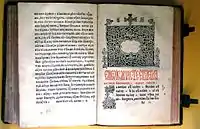Belgrade printing house
The Belgrade printing house was a printing house established by count (Serbian: knez) Radiša Dmitrović in Belgrade, Ottoman Serbia (today the capital of Serbia). It was the first printing house in Belgrade.[1] After Dmitrović's death, the printing house was taken over by Trojan Gundulić, who organized publishing of the first and only book of this printing house, the Gospel, printed and edited in 1552 by Hieromonk Mardarije.
 The Four Gospels printed at the Belgrade printing house, 1552 | |
| Status | defunct (1552) |
|---|---|
| Founded | 1552 |
| Founder | Radiša Dmitrović |
| Successor | Mrkšina crkva printing house |
| Country of origin | Ottoman Empire (today Serbia) |
| Headquarters location | Belgrade |
| Key people | |
| Publication types | srbulje |
Under Dmitrović
Count Radiša Dmitrović, a Serb nobleman[2] and native of Herzegovina,[3] bought the printing press and types and employed Hieromonk Mardarije as editor[4] and printer. Some earlier sources speculated that the Belgrade in question was actually Berat in Albania or some other Belgrade on the Balkans. Dmitrović died before the first book was printed in his printing house.[5] According to some sources, he died before the printing press he bought was even delivered to him, while some other sources say he died during the printing of the first book.[6][7]
Under Gundulić
After Dmitrovićs death, the printing press was received by Trojan Gundulić, a member of the noble Gondola family,[8][9] who lived in the large colony of Ragusans in Belgrade[10] as an illegitimate son of a Ragusan nobleman.[11] Gundulić moved the press to his house, which was located in the part of the Belgrade called Zerek, near the Bayrakli mosque, which is today Gospodar Jevremova Street.[6] Gundulić personally sold books in Belgrade.[12] Gundulić did not find the printing business profitable, however, and did not continue with it.[13]
Aftermath
Hieromonk Mardarije moved the printing press from Belgrade to the Mrkšina crkva monastery and established the Mrkšina crkva printing house there.[14][15] According to some sources, it was Mardarije who inspired first Dmitrović and then Gundulić to invest in the printing business and who organized all activities during the set-up of the printing house in Belgrade.[16] A copy of The Four Gospels is kept in the treasury of the Blagoveštenje Monastery.[17]
See also
References
- Plavšić, Lazar (1959). Srpske štamparije: od kraja XV do sredine XIX veka. Udruženje grafičkih preduzeća Jugoslavije. p. 144.
- (Greece), Hidryma Technologias kai Ereunas (2005). Provincial elites in the Ottoman Empire: Halcyon Days in Crete V : a symposium held in Rethymnon 10-12 January 2003. Crete University Press. p. 66. ISBN 978-960-524-216-9.
Knez Radisa Dimitrovic, of Serbian origin, founded the first printing press in Belgrade in 1552
- Поповић, Душан Ј (1964). Beograd kroz vekove. Туристичка штампа. p. 102.
Тројан Гундулић мора да је био врло окретан и способан човек, када му је кнез Радиша Дмитровић (родом из Херцеговине)...
- Beogradu, Univerzitet u (1954). Beograd kroz vekove: Ciklus predavanja, održan na Kolarčevom narodnom univerzitetu. Kolarčev narodni univerzitet. p. 49.
- Српско учено друштво (1885). Гласник Српскога ученог друштва ... p. 200.
Слова за ову штампарију (ффрин cie) набавио је кнез Радиша Дмитровић и спремао се, да штампа црквене књиге, али напрасно оболи и остави сав штампарски прибор у свом дому, који после на понуду ...
- Jovanović, Živorad P. (1964). Iz starog Beograda. "Turistička štampa". p. 97.
- Godis̆njak grada Beograda. Beogradske novine. 1957. p. 381.
Радиша није имао срећу да доживи и њено остварење. ... Кад је уређај штампарије приспео у Београд, преузео га је Ду- бровчанин Тројан Гундулић.
- Medaković, Dejan. Izabrane srpske teme: studije i prilozi. Beogradski izdavačko-grafički zavod. p. 118.
Оснивач београдске штампарије, кнез Радиша Дмитровић, умро је у току њеног рада. После Дмитровићеве смрти, његову штампарију преузима дубровачки трговац Тројан Гундулић, је- дан од познатијих чланова дубровачке ...
- Simpozijum seoski dani Sretena Vukosavljevića. Opštinska zajednica obrazovanja. 1995. p. 312.
Ђорђић каже: Мардарије је 1552, године штампао Еванђеље у Београду у штампарији коју је био основао кнез Радиша Дмитровић, а после његове смрти водно Трајан Гундулић Дубровчанин. 1562. године јеремонах Мардарије ...
- Popović, Bogdan; Skerlić, Jovan (1940). Srpski književni glasnik. p. 312.
- Prilozi za književnost, jezik, istoriju i folklor. Drzhavna štamparija Kralevine srba, khrbata i slovent︠s︡a. 1975. p. 139.
У њему је 1552. године Тројан Гундулић „от великаго града Дубровника", у ствари трговац и берберин, и ванбрачни син дубровачког ...
- sinod, Srpska pravoslavna crkva. Sveti arhijerejski (1970). Glasnik. p. 13.
И сам Трајан Гундулић, који је радио на штам- пању 1552. „Четворојеванћеља" бавио се про- дајом књига у Београду
- Летопис Матице српске. У Српској народној задружној штампарији. 1995. p. 385.
Биће да Дубровчанин није остварио значајније послове у штампању књига, па је престао ...
- Annuaire du musee de la ville de Beograd. Beogradske novine. 1955. p. 91.
Неки наши научници сматрају да је ту штампарију понео собом у Мркшину Цркву јеромонах Мардарије.
- Vojska. Vojnoizdavački i novinski centar. 2004. p. 167.
Штампарија из Београда пренета је у Мркшину цркву код ...
- Srpsko geografsko društvo (1922). Glasnik Srpskog geografskog društva: Bulletin de la Société serbe de geographie. Srpsko geografsko društvo. p. 189.
Сва три, пак, записа утврђују : да је јеромонах Мардарије, оснивач штампарије, био један од калуђера велике главе и истрајне ...
- Tasić, Jelena (18 December 2015). "Manastir Vavedenje: Kraj klisure na tragovima baroka". Danas. Retrieved 9 August 2020.
Sources
- Ćirković, Sima (2004). The Serbs. Malden: Blackwell Publishing.CS1 maint: ref=harv (link)
Further reading
- Pavle Ivić; Mitar Pešikan (1995). "Serbian Printing". The History of Serbian Culture. Project Rastko.